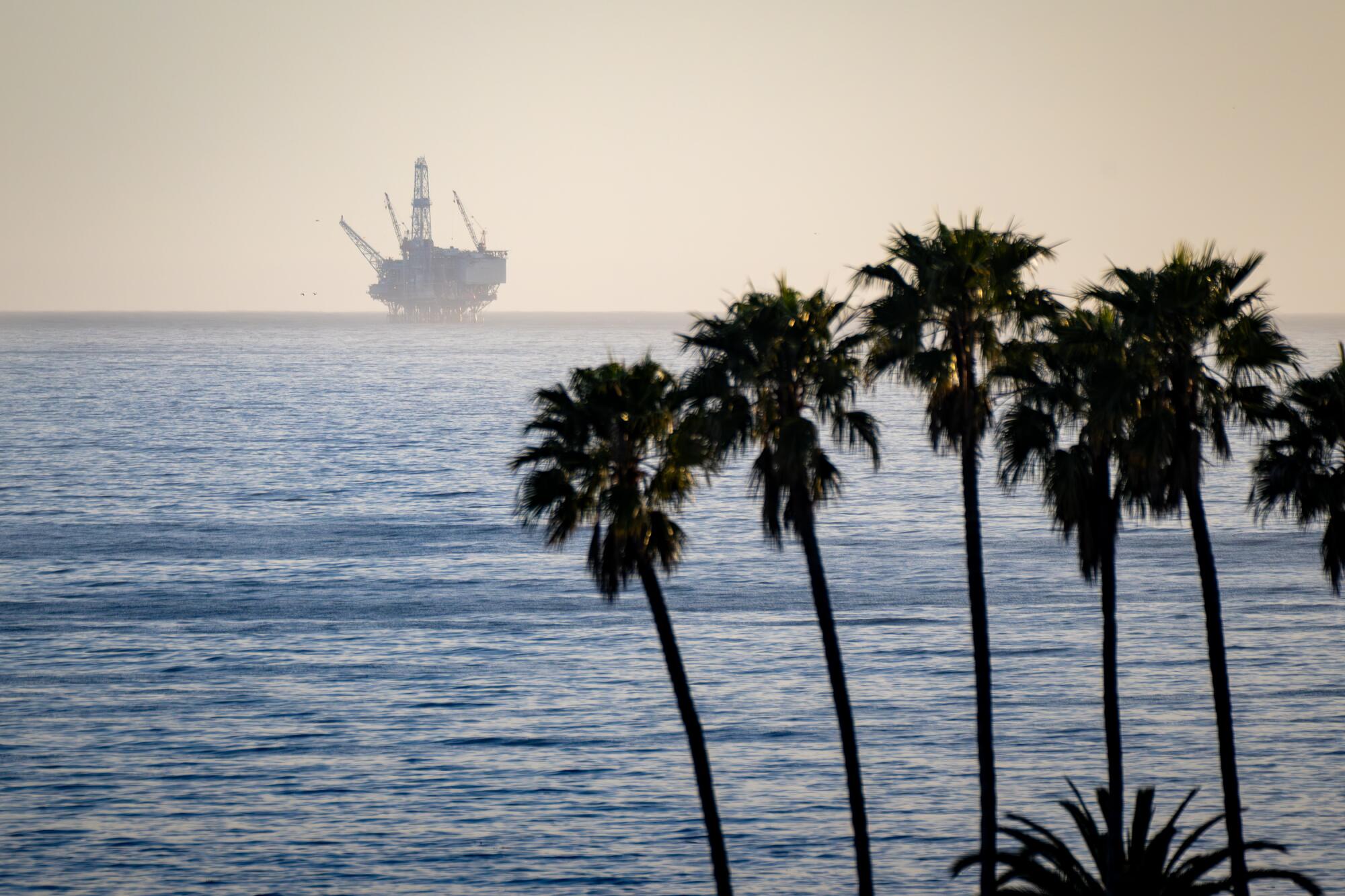
- Share via
Almost 10 years to the day after a massive oil spill fouled the Santa Barbara coastline and prompted the closure of several drilling platforms, a Texas-based company says it has resumed crude oil production in nearby federal waters.
To the shock and outrage of environmental activists and some state and local officials, Sable Offshore Corp. announced that it started extracting oil last week from one of three long-shuttered platforms.
The announcement comes just one month after the California Coastal Commission ordered the company to stop work and levied an $18-million fine for failing to obtain necessary permits and reviews. Sable disputes the commission’s authority and insists that it has obtained all necessary permits for the work it’s begun.

The development has enraged environmental groups, who claim Gov. Gavin Newsom and his administration have not done enough to help avert a future spill.
“It’s alarming that no agency comprehensively looked at the environmental risks of restarting this aging, corroded pipeline, and that Sable steamrolled over orders to halt construction,” read a statement from Miyoko Sakashita, the Center for Biological Diversity’s oceans director. “We’ll keep working to protect the sensitive habitats, species and communities harmed by offshore oil drilling.”
The California Coastal Commission has ordered Sable Offshore Corp. to cease and desist in its bid to revive oil drilling off the coast of Santa Barbara.
The resumption of oil production off Santa Barbara coincides with a push by the Trump administration to expand fossil fuel production and roll back clean energy initiatives.
Jim Flores, Sable’s chairman and chief executive, called the new oil production a “milestone achievement” that will help bring “energy security to the state of California.”

Sable “is proud to have safely and responsibly achieved first production at the Santa Ynez Unit,” Flores said in a statement Monday. “The impressive well tests from Platform Harmony confirm the prolific nature of the Santa Ynez Unit reservoir after being dormant for ten years.”
According to the company, Harmony is now extracting oil at a rate of about 6,000 barrels a day from six wells. That oil is being sent to the onshore Las Flores Canyon processing facility, and will be stored there until full operations can restart.
The May 2015 spill that shut down operations occurred when a corroded section of onshore pipeline ruptured, spewing an estimated 140,000 gallons of crude oil near Refugio State Beach.
Much of Sable’s recent work has centered on repairing those pipelines, which were owned and operated by a different company at the time of the spill. That infrastructure still requires several outstanding approvals, including testing and plan reviews. Sable officials say the oil production that began last week involves a separate section of its operations, and has already won necessary approvals.
Environmentalists across Santa Barbara have condemned Sable’s resumption of oil production.
“Any responsible company would not have started producing until they have approval to restart the pipeline,” said Linda Krop, chief counsel for the Environmental Defense Center, a group that formed after Santa Barbara’s first major oil spill in 1969. She described the restart as premature, perhaps even an attempt to pressure the remaining state agencies into expediting the remaining regulatory hurdles.
The timing of the announcement was particularly galling for some.

“Making this announcement on the 10-year anniversary of the second-most devastating oil spill in Santa Barbara history is just plain cruel, and it shows a complete disregard to the residents who lived through the spill and the hundreds of birds and sea animals that died,” said Maureen Ellenberger, chair of Sierra Club’s Santa Barbara-Ventura Chapter. “We’ll continue fighting this dangerous, unpopular pipeline until it is closed for good.”
Alice Walton, a spokesperson for Sable, said in a statement that “the timing has nothing to do with the anniversary,” pointing out that crude began flowing May 15 — four days before the exact anniversary.
While she conceded there are still some remaining hurdles for the onshore pipelines to become fully operational, she downplayed other legal challenges — of which there are many.
“It’s our position the lawsuits are without merit and will not impact the project,” Walton said.
Perhaps the biggest legal hurdle is the dispute Sable has with the coastal commission. The company has ignored commission demands that it cease work and has filed suit against the commission, accusing it of overstepping its authority.
“The Coastal Commission is profoundly disappointed that Sable has refused to follow state law in its ongoing efforts to restart offshore oil production in Santa Barbara,” Coastal Commission Executive Director Kate Huckelbridge said in a statement Monday. “Our agency continues to coordinate closely with the state Attorney General to determine the appropriate next steps.”
A Houston-based oil company has rebuffed the authority of the California Coastal Commission in a bid to revive drilling off the coast of Santa Barbara.
If Sable is successful in fully reviving the offshore operation, it would mark a major reversal for California climate policy, which for years has slowly reduced the state’s production of fossil fuels in favor of clean energy. It also comes in stark contrast to a wave of environmental activism in Santa Barbara County, where residents have rallied several times against the Sable project and county leaders recently voted to find a way to slowly phase out all oil and gas operations.

“To be clear, this is happening on Gov. [Gavin] Newsom’s watch,” read a statement from Alex Katz, the executive director of the Environmental Defense Center. “At critical points, his administration has allowed this project to move forward in the face of overwhelming local and state-wide opposition. ... California should be leading on the climate crisis, not facilitating a high-risk fossil fuel project in our own state.”
A spokesperson for the governor referred questions from The Times about Sable’s restart efforts to California’s Natural Resources Agency, an umbrella agency that includes the California Coastal Commission, the Office of the State Fire Marshal and other key departments in oil oversight. Kirsten Macintyre, a spokesperson for CNRA, declined to answer questions about the governor’s or state’s position regarding Sable’s project, but said the agency is working with all entities involved “to evaluate the whole picture.”
She pointed to an agency document that lists the eight state agencies involved in oversight of the Sable project and where they are in their process.
Sable said that it not only plans to begin operating more wells at Harmony, but it will also restart 70 wells at its other two platforms, Heritage and Hondo, come July and August. The company said it expects to fill the processing plant’s storage capacity of almost 540,000 barrels by mid-June and begin oil sales in July. The three offshore platforms, the onshore processing facility and the onshore and offshore pipelines collectively make up the Santa Ynez Unit.
But the company shared those plans with a long caveat, part of which focused on the ongoing requirements from California oversight agencies.
“There can be no assurance that the necessary permits will be obtained that would allow the onshore pipeline to recommence transportation and allow the [Santa Ynez Unit] assets to recommence sales,” the company said.
Tips, publicity and police work helped lead Los Angeles officials to the man they say cut down or damaged 13 trees over the span of seven days in April.
The most significant approvals that remain will be reviewed by the state’s fire marshal. Kara Garrett, a deputy state fire marshal, said there are still “a number of conditions that must be met prior to authorization of restart.”
“This includes, but is not limited to, repair work, hydrotesting of the lines, and a submission and OSFM approval of a pipeline startup plan,” Garrett said in a statement.

Earlier this month, the California Department of Conservation, which includes the Geologic Energy Management Division (CalGEM), also alerted Sable that the Las Flores Processing Facility was subject to its oversight — something Sable had contested. The letter, dated May 9, said the division was awaiting spill contingency and pipeline management plans from the company, and warned that financial penalties could follow without a timely response. It wasn’t immediately clear if Sable had complied with that order.
Legal roadblocks are also still possible.
The Environmental Defense Center, along with other climate-focused groups, have sued the state fire marshal’s office, contending the department failed to conduct necessary environmental reviews when it granted some prior approvals for Sable’s pipeline work.
Sable has also sued the Santa Barbara Board of Supervisors to try to obtain a necessary permit transfer for the restart project. The county initially granted a transfer from the unit’s prior owner, Exxon Mobil, to Sable, but upon appeal, supervisors deadlocked over the matter, which had kept the permits from Sable.
In another case, the Center for Biological Diversity has filed suit against the Trump administration over its approvals of the restart, claiming federal officials failed to require updated plans for the decades-old infrastructure that was originally approved for production in the 1970s and 1980s.
More to Read
Sign up for Essential California
The most important California stories and recommendations in your inbox every morning.
You may occasionally receive promotional content from the Los Angeles Times.

















